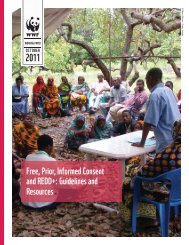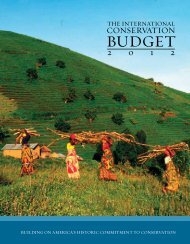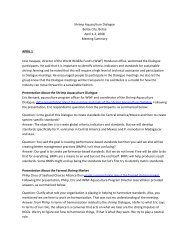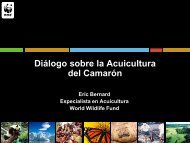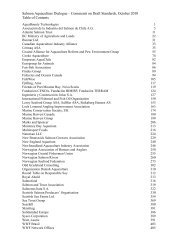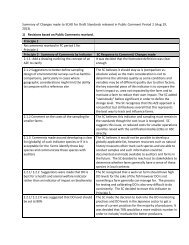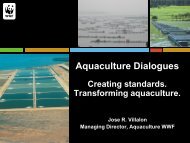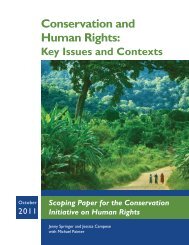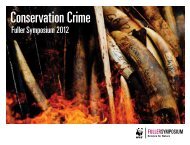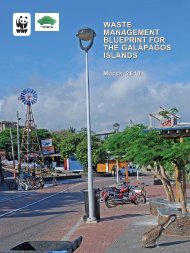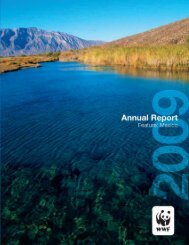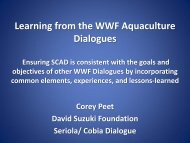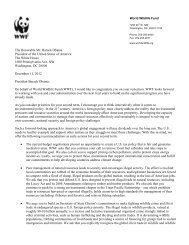Amazon - World Wildlife Fund
Amazon - World Wildlife Fund
Amazon - World Wildlife Fund
Create successful ePaper yourself
Turn your PDF publications into a flip-book with our unique Google optimized e-Paper software.
© Nils WARnock, UC Davis, MAP couRTEsy GNPS<br />
© Michel GunthER / WWF-cAnon, © PABlo JAMioy<br />
WWF Program Officer Dennis Jørgensen releases a long-billed curlew<br />
during a tagging expedition.<br />
These maps from the VMS system are used by the Galápagos National Park<br />
Service to continuously monitor and control the activities of fishing vessels<br />
above 20 metric tons operating inside the Galápagos Marine Reserve.<br />
The ecotourism opportunities generated by gorilla habituation programs<br />
create economic incentives for the local community to protect these<br />
charismatic primates.<br />
EFN Fellow Pablo Jamioy (in hat) with a group of indigenous park guards on<br />
patrol in the Kamentsa Indigenous Reserve, Sibundoy, Putumayo, Colombia.<br />
In addition, the Ministry<br />
of Agriculture is expected<br />
to enact a ministerial order<br />
restricting the harvesting of<br />
Korean pine.<br />
Both of these actions follow<br />
lobbying from WWF and,<br />
more immediately, the recent<br />
airing of an undercover exposé<br />
that ran on Russia’s “presidential”<br />
television channel.<br />
Using information provided<br />
by WWF, the show exposed<br />
illegal logging in Primorsky<br />
Province and indicted a corrupt<br />
government official.<br />
TRACKING CURLEWS<br />
ACROSS NORTH AMERICA<br />
WWF is in its second<br />
year of tracking long-billed<br />
curlews, the largest shorebird<br />
in North America. An<br />
imperiled species, curlews<br />
come to the Northern Great<br />
Plains each spring to breed<br />
in the grasslands, where<br />
they find good nesting habitat<br />
and plentiful insects to<br />
feed upon. In the summer<br />
and fall they migrate to the<br />
southern United States and<br />
Mexico. But habitat degradation<br />
and cultivation<br />
are altering their wintering<br />
grounds and their migration<br />
stopover habitat with<br />
unknown consequences.<br />
In the spring of 2009 in the<br />
grasslands of Montana,<br />
WWF and partners fitted<br />
seven long-billed curlews<br />
with lightweight solar-powered<br />
satellite transmitters.<br />
Scientists then watched in<br />
near real-time as the birds<br />
migrated up to 1,800 miles<br />
south. In collaboration<br />
with WWF’s Chihuahuan<br />
Desert Program and the<br />
Universidad Autonoma<br />
de Nuevo Leon, WWF<br />
deployed three additional<br />
satellite tags on curlews in<br />
the grasslands of Mexico<br />
in October 2009. This<br />
spring, WWF tagged eight<br />
more birds in Montana.<br />
This research is providing<br />
critical data for developing<br />
effective conservation<br />
strategies for the birds’<br />
habitat. The curlews’ great<br />
migration also highlights the<br />
interconnectivity of North<br />
American grasslands and the<br />
importance of our local work<br />
and its global ties.<br />
THWarting ILLEGAL<br />
FISHING IN THE<br />
GALÁPAGOS<br />
The nearly 53,000<br />
square-mile Galápagos<br />
Marine Reserve is one of<br />
the largest marine reserves<br />
in the world, home to<br />
whales, whale sharks, rays,<br />
swordfish, sea turtles and<br />
other species of commercial<br />
and ecological interest. But<br />
though it has long enjoyed<br />
legal protection from commercial<br />
fishing, the reserve<br />
still feels the impact of<br />
illegal fishing activity by<br />
industrial fishing fleets and<br />
traditional boats. Last year,<br />
WWF took significant steps<br />
to help fight this infringement<br />
on protected waters.<br />
It had been difficult for the<br />
reserve’s limited number of<br />
law enforcement patrols to<br />
cover such a vast area. So,<br />
to thwart damaging fishing<br />
activities, WWF helped to<br />
deploy a Satellite Vessel<br />
Monitoring System (Vms)<br />
that provides real-time data<br />
on the position, route and<br />
speed of every ship above<br />
20 metric tons operating<br />
inside the reserve. The data<br />
enables patrol boats to efficiently<br />
target trespassers.<br />
More recently, we recruited<br />
vessel monitoring experts<br />
from Alaska to design a<br />
similar system for monitoring<br />
smaller boats, so<br />
that 100 percent of ships<br />
can be tracked. In addition,<br />
WWF is funding the<br />
design and implementation<br />
of an on-board Automatic<br />
Identification System that<br />
can automatically transmit<br />
several reports per minute<br />
showing the route, speed,<br />
navigation status and identification<br />
of every ship in<br />
the reserve.<br />
With the implementation<br />
of both systems, WWF expects<br />
the Galápagos Marine<br />
Reserve will become one<br />
of the better-controlled<br />
marine protected areas in<br />
the world.<br />
DEVELOPING GORILLA<br />
ECOTOURISM IN THE<br />
CENTRAL AFRICAN<br />
REPUBLIC<br />
Ever want to get up<br />
close and personal with a<br />
gorilla? WWF has found<br />
a way to allow people to<br />
do this, while at the same<br />
time benefitting local communities<br />
and raising funds<br />
for conservation.<br />
Since 1997, WWF has supported<br />
the Dzanga-Sangha<br />
Primate Habituation<br />
Program in its efforts<br />
to develop ecotourism<br />
through gorilla viewing.<br />
Local trackers have<br />
been employed to help<br />
habituate western lowland<br />
gorillas to the presence of<br />
humans. After some initial<br />
challenges, the first family<br />
of gorillas was successfully<br />
habituated and ecotourism<br />
opened in 2001.<br />
Today, hundreds of visitors<br />
each year observe the<br />
12 gorillas in the Group<br />
Makumba, named for its<br />
male silverback leader.<br />
Another group has been<br />
habituated since, and<br />
two more are in the process,<br />
creating financial<br />
opportunities for the<br />
local community and incentives<br />
to protect these<br />
magnificent creatures.<br />
CLIMATE<br />
GUIDING LAND-USE<br />
PLANNING IN SUMATRA<br />
Deforestation is causing<br />
biodiversity loss and<br />
degrading many ecosystem<br />
services in Sumatra.<br />
These services – the<br />
benefits nature provides<br />
us – include clean water,<br />
flood control, climate<br />
regulation, crop pollination,<br />
food, medicine,<br />
recreation and spiritual<br />
fulfillment. They are difficult<br />
to quantify, and<br />
are therefore typically ignored<br />
in decisions about<br />
land use – until now.<br />
A tool developed by the<br />
Natural Capital Project –<br />
a joint venture of WWF,<br />
Stanford University and The<br />
Nature Conservancy – is<br />
now being used by WWF<br />
and other nongovernmental<br />
organizations in Sumatra<br />
to map and value ecosystem<br />
services. InVest<br />
(Integrated Valuation of<br />
Ecosystem Services and<br />
Trade-offs) provides mapped<br />
information about where on<br />
the landscape ecosystem services<br />
are supplied, and how<br />
these patterns might change<br />
under future land-use scenarios.<br />
It can be overlaid<br />
with biodiversity information<br />
to see where ecosystem<br />
services and conservation<br />
priorities overlap.<br />
Working with a group<br />
known as Forum Tata<br />
Ruang Sumatera, WWF is<br />
using this information to<br />
make recommendations to<br />
local governments as they<br />
complete mandated landuse<br />
plans. For example,<br />
InVest results will indicate<br />
promising areas in which<br />
to encourage sustainable<br />
land use and conservation<br />
by establishing profitable<br />
incentives such as ecotourism,<br />
payments for watershed<br />
services, forest carbon projects,<br />
and certified forestry<br />
and agriculture.<br />
BUILDING INDIGENOUS<br />
CAPACITY IN THE AMAZON<br />
WWF’s Russell E. Train<br />
Education for Nature<br />
Program strives to build a<br />
dynamic and highly qualified<br />
corps of conservation leaders<br />
in Africa, Asia and Latin<br />
America by awarding education<br />
fellowships to people<br />
who can use their training to<br />
bring increased sustainability<br />
to their home communities.<br />
Pablo Herman Jamioy<br />
Juajibioy, who received a<br />
fellowship in 2006, has leveraged<br />
his education to win<br />
additional WWF and <strong>World</strong><br />
Bank grants that allow him<br />
to wed traditional terminology<br />
and ideas from his<br />
Kamentsa Indian culture<br />
14 worlDWildliFE.ORG/pulse Pulse: The hEART of consERvATion 15



